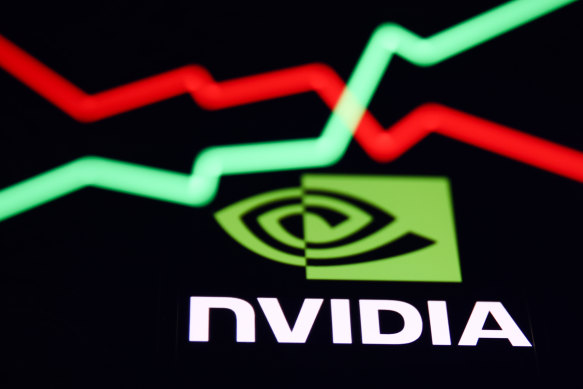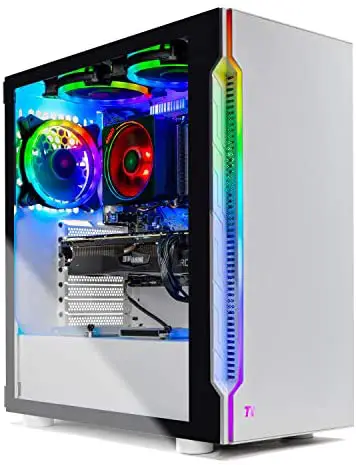By Dan Miles
The rally in the US sharemarket this year has been driven by technology shares, but it is faltering, with echoes of the dotcom bust of 2000. We could see share price falls accelerate in coming months with US interest rates expected to remain relatively high and geopolitical risks rising.
While investors in expensive artificial intelligence (AI) stocks may ultimately be proven right, there are plenty of safer places to park your money given the geopolitical risks, persistently high inflation and relatively high interest rates.
Double-digit gains in the US sharemarket this year have been fuelled by optimism that AI will unlock a new wave of growth for technology companies, justifying the sector’s eye-watering valuations.

The rally in the US market this year has been driven by technology shares such as Nvidia, but it is faltering.Credit: Getty
However, with war raging in the Middle East and Russia, the US economy slowing and bond yields and oil prices rising, sharemarket volatility is rising. A global recession looks like a higher probability outcome in coming months and investors are worried about the repercussions on portfolios, asking which sharemarket sectors could provide the greatest protection.
It is very unlikely to be the technology sector.
Scepticism has grown, and it’s believed their values can’t be justified as the cost of capital climbs. Benchmark 10-year US Treasury yields are at around 16-year highs after the US Federal Reserve surprised investors by flagging the potential for an additional rate hike this year and fewer cuts next year.
Loading
US tech shares have been under pressure, with the Nasdaq Composite Index down around 5 per cent over the 10 trading days to October 20. As measured by the S&P 500, US shares are down around 3 per cent. Over the past month, several of the “Magnificent 7” technology companies – Tesla, Apple, Amazon.com, Nvidia, Microsoft and Google’s owner Alphabet – have fallen on average 7.5 per cent as at October 20.
But there could be more losses if interest rates stay relatively high, as the US Federal Reserve has hinted. This year’s technology rally defies logic, with interest-rate sensitive technology stocks having risen despite dramatically higher US Treasury bond yields.
We could be seeing the start of a broader technology sell-off, with the Nasdaq Composite Index posting its second consecutive monthly drop this year in September 2023. Still, values are much higher than they were a year ago.
Investors considering a technology investment must not forget that the price paid for companies drives long-term returns, and they might have to wait for a long time for decent returns if they buy into US shares at current levels.
Technology booms can turn into busts. In the late 1990s, online retail giant Amazon was one of the winners in the dotcom rally, but its stock went from over $US5 in December 1999 and fell to just over 30¢ in 2001. Microsoft dropped from $US58 in 1999 to $US22 in 2000 – investors had to wait 16 years for Microsoft and 11 years for Amazon to get their money back.
A similar scenario could play out given the risk of persistent inflation, higher interest rates and a potential global economic contraction as the world worries about war.
For investors, that means they need to keep an eye on valuations or the price they pay for shares, and they should be prepared to look in places that others aren’t looking – that is, outside the technology sector.
It takes a lot more work, and can be uncomfortable for periods of time – it is always more comfortable moving with the herd. However, you may be able to uncover investments that could provide superior potential outcomes in an array of economic scenarios, as opposed to betting on a single outcome – that is, that the technology boom will be ongoing.
When you can find opportunities that can benefit from multiple scenarios, especially the highest probability ones, it pays to try and stack the odds in your favour and take advantage of them.
Our internal study of corporate earnings and profit margins has shown that from market troughs, sectors that offered the strongest earnings growth and operating margins on average and across multiple geographic regions were energy, real estate, consumer discretionary, financials and healthcare companies. In contrast, we think the US sharemarket leaders are more likely to disappoint than impress soon.
Dan Miles is the managing director at Innova Asset Management and is responsible for overall portfolio management of Innova’s managed account portfolios.
- Advice given in this article is general in nature and is not intended to influence readers’ decisions about investing or financial products. They should always seek their own professional advice that takes into account their own personal circumstances before making any financial decisions.
Most Viewed in Money
Loading

